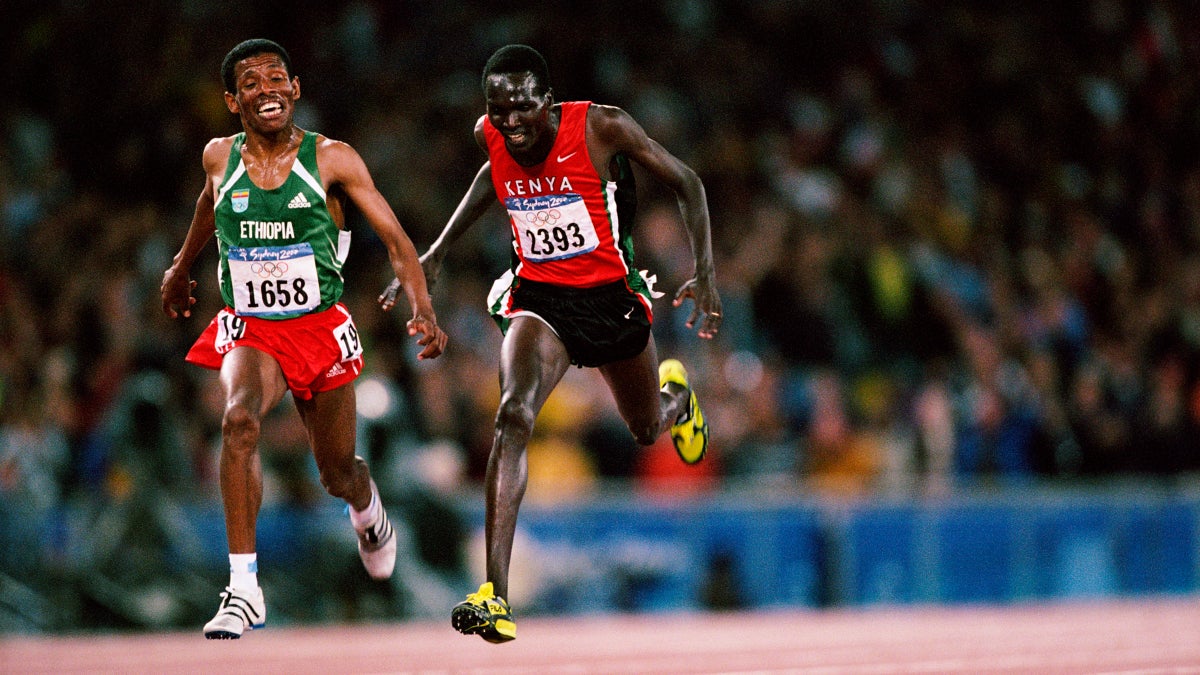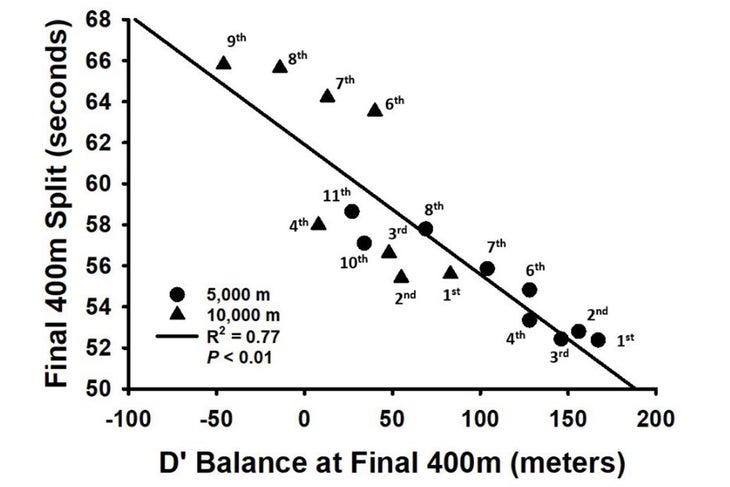
If you have not rewatched the epic ending-straight duel between Paul Tergat and Haile Gebrselassie from the 2000 Olympics just lately, do your self a favor and click on here. Okay, now you are in the mood for a person of the perennial operating debates: where by do incredible kickers like Geb get their amazing kicks from?
There are 3 main educational facilities of considered. A person is that sprint speed is the prerequisite for a speedy sprint finish, an plan not too long ago fleshed out by proponents of the pace reserve concept. A second is that the fastest finishers are merely those who are the very least drained at the finish of the race, so good stamina is the vital. A 3rd is that it is all in your head—that Geb’s capacity to narrowly outlean Tergat virtually each and every time they raced is finest explained by distinctions in self-perception alternatively than physiology.
But possibly there’s a far better clarification. A team of scientists led by Brett Kirby of Nike Sport Study Lab, along with collaborators which include Andrew Jones of the College of Exeter, who labored with Kirby on Nike’s Breaking2 venture, not too long ago published a paper in the Journal of Utilized Physiology that employs a uncomplicated mathematical model to predict how pacing procedures affect runners with different strengths and weaknesses. The model generates a entire pile of attention-grabbing insights, but the one particular that grabbed my interest was its ability to properly forecast how rapidly every single runner will run the final lap of a offered race.
The paper was motivated by the men’s 5,000- and 10,000-meter activities at the 2017 Earth Championships, in which the mind-boggling favourite Mo Farah, unbeaten at significant championships over individuals distances considering that 2011, defended his 10,000 title but was outkicked by Muktar Edris in the 5,000. Was there one thing in the way the two races performed out that produced these results? And much more importantly, the researchers wondered, could the outcomes have been predicted in progress?
The model that Kirby and his colleagues use depends on a concept named important pace. I’ve published about it a several instances ahead of, and the total review is cost-free to examine online for those people who want to dig into the aspects. For our uses, important pace is mainly a threshold that divides metabolically sustainable endeavours from unsustainable ones. At the time you are heading more quickly than critical pace, as races between 800 and 10,000 meters inevitably do, the clock is ticking down to your eventual exhaustion. How very long that usually takes, or equivalently how substantially vitality you can expend earlier mentioned that essential threshold, is dependent on a 2nd parameter—a form of spare gasoline tank—that is at times called anaerobic potential. (The terminology is controversial for various complex reasons, but I’m heading stick with anaerobic capacity mainly because I never know of any better choices. In the paper, they just get in touch with it D’, and it’s expressed in models of length. I like to believe of it as the utmost length you could sprint before keeling over if you held your breath, but which is a metaphor instead than a physiological explanation.)
The paper analyzes the success of both equally the 5,000- and 10,000-meter races from those people 2017 championships. For each and every athlete, the researchers determine a vital pace and an anaerobic capacity based on former race effects (as explained right here). All those parameters give you a prediction of who would get the race—but that prediction assumes that every person is heading to operate a properly even tempo that maximizes their own abilities, by running just ample a lot quicker than their significant velocity to exhaust their anaerobic ability as they cross the end line.
That’s not how issues get the job done in the real entire world, though—because the pace may differ continuously relying on who’s top and what ways the runners are employing. If the first speed is fast, it will drive runners to begin burning up their anaerobic reserve appropriate absent, which favors competition with significant significant speed. If the original pace is gradual, then the race will appear down to a late burn up-up that favors these with significant anaerobic potential. This is not a especially deep perception: rapid races favor cardio monsters and sluggish races favor kickers.
But real-everyday living championship races are rarely all fast or all gradual the tempo may differ continuously as runners surge, take it easy, and counterattack. Each runner’s exceptional anaerobic reserve is draining whenever the pace is speedier than their special crucial velocity, and recharging when the speed is slower. Employing the lap-by-lap splits of the 2017 championship racers, Kirby and his colleagues are equipped to recalculate where just about every runner stands right after every lap. At the start of the race, knowing the runners’ crucial velocity and anaerobic reserve doesn’t give you a very superior prediction of what purchase they’ll eventually finish in. But with just about every passing lap, the prediction receives better and better—until, with 400 meters to go, the numbers give you a near-best forecast of how the race will enjoy out.
In element, the prediction gets far better mainly because weaker runners drop off the pace as their anaerobic capacity hits zero. That is what transpired in the 10K, so there ended up only 6 adult males left in contention for the remaining lap. In the 5K, which was a slower, more tactical race, the full industry was nonetheless in the blend at the bell. In the two instances, the ending order—and, to a amazing extent, the instances for the closing 400 meters—were predicted not by who was the swiftest sprinter or experienced the ideal endurance, but by who had the most anaerobic capability remaining at that correct instant in time, immediately after 4,600 or 9,600 meters of surges and countersurges.
The consequence? With a lap to go in the 5K, Muktar Edris was favored to gain, despite beginning the race as the fourth seed, according to the model. Yomif Kejelcha, the model’s prerace most loved and the runner who, in authentic lifestyle, was primary the race as the remaining lap commenced, was now predicted to finish only fourth based mostly on his depleted anaerobic ability. Farah was picked for second, with American Paul Chelimo, who had fallen back to sixth, picked for 3rd. That’s precisely how it played out: the design correctly predicted the spots of all nine runners for whom it experienced enough pre-race information to estimate their important speed and anaerobic capability.
Here’s a graph exhibiting time for the last lap as a purpose of anaerobic capacity remaining at the start off of that lap (that is D’, revealed as a length in meters):

The larger the remaining anaerobic capacity, the more quickly the last lap. It’s not ideal: you can see that the third-area finisher in the 5,000, Chelimo, really shut marginally speedier than the two adult males in advance of him, despite having a lot less D’ to burn. But overall, it is uncannily precise at predicting the notoriously tricky-to-forecast finishing kick.
The crucial place right here is that neither stamina nor sprint pace, on their possess, would have pegged Farah as a close to-unbeatable championship runner for six years. He did not have the best significant pace in possibly the 5K (that was Kejelcha) or the 10K (that was Kenya’s Paul Tanui). He experienced only the fourth-biggest anaerobic potential in both the 5K and 10K. But he somehow mastered the artwork of riding the razor’s edge of his crucial speed and managing the closing levels of races in get to achieve the very last lap with the most anaerobic capacity left.
The stage? Most likely if you know someone’s critical velocity and anaerobic potential (which can be approximated from their best race occasions at 3 various distances), you can devise the very best method to beat them, based on regardless of whether you have a far better significant velocity or anaerobic capability. Possibly, for far better or worse, we’ll at some point have serious-time estimates of anaerobic capability shown on our wrists as we race. But I’ll confess: no subject how numerous situations I view Geb reel in and then outlean Tergat, I’m nevertheless not persuaded there’s any physiological product that can fully capture that magic.
For extra Sweat Science, be a part of me on Twitter and Facebook, indicator up for the email newsletter, and verify out my e book Endure: Brain, Overall body, and the Curiously Elastic Restrictions of Human Effectiveness.
The post Why Sprinters Really don’t Have the Fastest Ending Dash appeared first on Outside On the net.

More Stories
Spark Your Day with Health Articles
Energize Your Life with Health Articles
Jumpstart Your Day with Health Articles